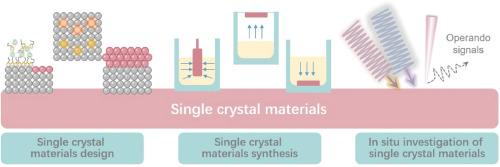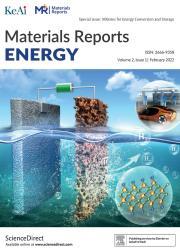Optimization of single crystal surface and interface structures for electrocatalysis
IF 13.8
引用次数: 0
Abstract
For emerging renewable and sustainable energy technologies, single crystal materials have become key materials to enhance electrocatalytic performance because of their atomic-level ordered structures and tailorable surface and interfacial properties. Various single crystal types, including metals, semiconductors, ceramics, organics, and nanocrystals, exhibit superior catalytic selectivity and stability in reactions such as water splitting and carbon/nitrogen cycles, benefiting from high electrical conductivity, tunable energy bands, and active sites with high surface energy. Through surface modification, interfacial atomic doping, and heterostructure construction, the distribution of active sites, electronic structure, and mass transport can be precisely regulated, significantly optimizing the catalytic kinetics of single crystal materials. In situ characterizations elucidate catalytic mechanisms at the atomic scale, while emerging methods like AI-assisted synthesis and bio-template directed growth offer pathways to overcome bottlenecks in the precision and cost of single crystal preparation. In addressing stability challenges in complex environments, strategies such as organic-inorganic hybridization and gradient interface design effectively mitigate interfacial instability. Future research should focus on cross-scale structural regulation and multidisciplinary integration to facilitate the transition of single crystal electrocatalysts from fundamental research to industrial applications, enabling efficient energy conversion.

电催化单晶表面及界面结构的优化
对于新兴的可再生和可持续能源技术,单晶材料由于其原子级有序结构和可定制的表面和界面特性而成为提高电催化性能的关键材料。各种单晶类型,包括金属、半导体、陶瓷、有机物和纳米晶体,在水分解和碳/氮循环等反应中表现出优异的催化选择性和稳定性,这得益于高导电性、可调谐的能带和具有高表面能的活性位点。通过表面修饰、界面原子掺杂和异质结构的构建,可以精确调控活性位点的分布、电子结构和质量输运,显著优化单晶材料的催化动力学。原位表征阐明了原子尺度上的催化机制,而人工智能辅助合成和生物模板定向生长等新兴方法为克服单晶制备的精度和成本瓶颈提供了途径。为了应对复杂环境下的稳定性挑战,有机-无机杂交和梯度界面设计等策略有效地减轻了界面的不稳定性。未来的研究应注重跨尺度结构调控和多学科整合,促进单晶电催化剂从基础研究向工业应用过渡,实现高效的能量转换。
本文章由计算机程序翻译,如有差异,请以英文原文为准。
求助全文
约1分钟内获得全文
求助全文
来源期刊

材料导报:能源(英文)
Renewable Energy, Sustainability and the Environment, Nanotechnology
CiteScore
13.00
自引率
0.00%
发文量
0
审稿时长
50 days
 求助内容:
求助内容: 应助结果提醒方式:
应助结果提醒方式:


